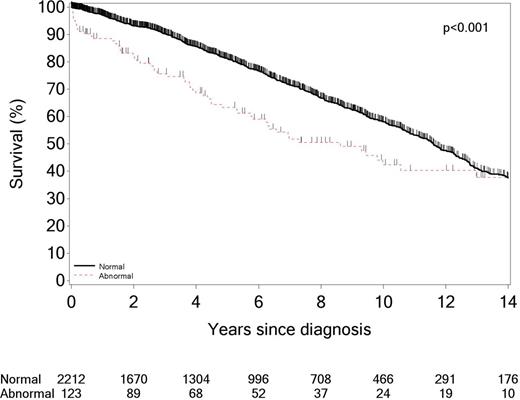Abstract
INTRODUCTION: The prevalence of liver dysfunction in patients with previously untreated chronic lymphocytic leukemia (CLL) is unknown; knowledge of which may provide important context for emerging therapeutic options with possible hepatotoxicity. The impact of liver dysfunction on outcomes of CLL patients is not well described.
METHODS: Between 09/1993 and 04/2016, previously untreated CLL patients seen in the Division of Hematology at Mayo Clinic at diagnosis (<12 months) and who had baseline assessment of at least one of the following liver function tests (LFTs): alkaline phosphatase (ALP), aspartate aminotransferase (AST), alanine aminotransferase (ALT), or total bilirubin were included in this analysis. Baseline lab values were defined as the closest value to CLL diagnosis for each lab within 12 months prior to diagnosis up through 6 months after CLL diagnosis. Patients with at least one abnormal LFT (defined as greater than 1.5 x the upper limit of normal) were classified as having liver dysfunction at diagnosis. Analysis for factors related to baseline liver function was performed using age- and sex-adjusted logistic regression models. Kaplan-Meier methods and multivariable Cox regression analysis was used to evaluate time to first treatment (TTFT) and overall survival (OS).
RESULTS: Of 2336 previously untreated CLL patients who met the inclusion criteria, 123 (5%) patients had at least one abnormal LFT value at time of diagnosis. Thirty five patients had abnormal AST (median value 106 U/L, range 72-745 U/L, reference range 8-48 U/L), 25 patients had abnormal ALT (median 112 U/L, range 82-313 U/L, reference 7-55 U/L), and 54 patients had abnormal total bilirubin (median 2.10 mg/dL, range 1.8-26.5 mg/dL, reference range ≤ 1.2 mg/dL). Forty five patients had abnormal alkaline phosphatase; 35 patients in the year 2003 or later (median 198 U/L, range 172-2269 U/L, reference range 45-115 U/L) and 10 patients in 2002 or earlier (median 471.5 U/L, range 394-706 U/L, reference range 98-260 U/L).
Abnormal LFTs were more common among those with advanced Rai stage disease (Rai 0-II=4.7% vs. Rai III-IV=13.4%; p<0.001) and among patients with lower hemoglobin (median 13.1 g/dL vs. 13.9 g/dL; p<0.001) at diagnosis. No difference in the rate of abnormal LFTs was observed based on cytogenetic abnormalities detected by FISH or CD38, CD49d, ZAP-70 or IGHV gene mutation status. There was no significant difference in prior alcohol abuse history between patients with liver dysfunction at diagnosis (6%) and those without (5%) (p=0.63). Similarly, there was no significant difference in body mass index between groups (median 27.8 vs. 27.8; p=0.12).
After 12 years of follow-up, an estimated 69% of the cases with abnormal LFTs were treated. The most common type of treatments included anti-CD20 monoclonal antibody therapy only, followed by purine nucleoside based chemoimmunotherapy, and an alkylating agent with a monoclonal antibody. The median time to treatment was 4.3 years for cases with abnormal LFTs compared to 6.3 years for cases without abnormal LFTs (p=0.02). However, after adjusting for age, sex and Rai stage, there was no difference in TTFT among patients with abnormal LFTs at baseline compared to those with normal LFTs (hazard ratio [HR] = 1.2 (95% CI, 0.9-1.6); p=0.23).
The median survival of CLL patients with abnormal LFTs at diagnosis was significantly shorter than those with normal LFTs (8.6 vs. 11.6 years, p<0.001, Figure 1). After adjusting for age, sex and Rai stage, multivariable cox regression analysis showed that abnormal LFTs retained independent prognostic significance for OS with a HR of 1.4 (95% CI, 1.1-1.8; p=0.012).
CONCLUSION: At the time of CLL diagnosis, ~1 out of every 20 patients with previously untreated CLL has abnormal LFTs. These data provide context to the recent reports of hepatotoxicity with the use of signal inhibitors in untreated CLL. Although the presence of liver dysfunction at diagnosis does not seem to predict a shorter TTFT, the OS of these patients is significantly shorter compared to patients who have normal LFTs.
Ding:Merck: Research Funding. Kenderian:Novartis: Patents & Royalties, Research Funding. Kay:Pharmacyclics: Research Funding; Tolero Pharmaceuticals: Research Funding; Acerta: Research Funding; Gilead: Membership on an entity's Board of Directors or advisory committees; Morpho-Sys: Membership on an entity's Board of Directors or advisory committees; Infinity Pharm: Membership on an entity's Board of Directors or advisory committees; Celgene: Membership on an entity's Board of Directors or advisory committees. Shanafelt:Janssen: Research Funding; Pharmacyclics: Research Funding; GlaxoSmithkKine: Research Funding; Genentech: Research Funding; Cephalon: Research Funding; Celgene: Research Funding; Hospira: Research Funding. Parikh:Pharmacyclics: Honoraria, Research Funding.
Author notes
Asterisk with author names denotes non-ASH members.


